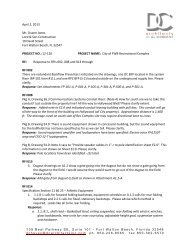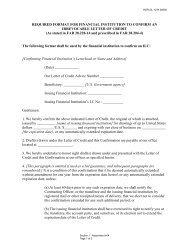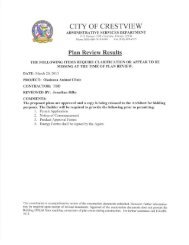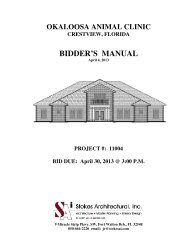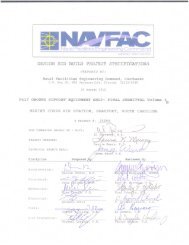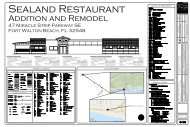- Page 1 and 2:
FINAL DESIGN SUBMITTAL FOR: RENOVAT
- Page 3 and 4:
Division 9 - Finishes Section 09 22
- Page 5 and 6:
SECTION 00102 LIST OF DRAWINGS PART
- Page 7 and 8:
SECTION 00103 SUMMARY OF PROJECT WO
- Page 9 and 10:
SECTION 01000 GENERAL REQUIREMENTS
- Page 11 and 12:
SECTION 01000 GENERAL REQUIREMENTS
- Page 13 and 14:
SECTION 01000 GENERAL REQUIREMENTS
- Page 15 and 16:
SECTION 01000 GENERAL REQUIREMENTS
- Page 17 and 18:
SECTION 01001 HVAC COORDINATION COM
- Page 19 and 20:
SECTION 01001 HVAC COORDINATION COM
- Page 21 and 22:
SECTION 01140 WORK RESTRICTIONS PAR
- Page 23 and 24:
SECTION 01150 QUALITY REQUIREMENTS
- Page 25 and 26:
SECTION 01150 QUALITY REQUIREMENTS
- Page 27 and 28:
SECTION 01150 QUALITY REQUIREMENTS
- Page 29 and 30:
SECTION 01150 QUALITY REQUIREMENTS
- Page 31 and 32:
SECTION 01330 SUBMITTAL PROCEDURES
- Page 33 and 34:
SECTION 01330A PROJECT SCHEDULE PAR
- Page 35 and 36:
SECTION 01330A PROJECT SCHEDULE 3.6
- Page 37 and 38:
SECTION 01355A ENVIRONMENTAL PROTEC
- Page 39 and 40:
PART 2 PRODUCTS (NOT USED) SECTION
- Page 41 and 42:
SECTION 01500 TEMPORARY CONSTRUCTIO
- Page 43 and 44:
SECTION 01500 TEMPORARY CONSTRUCTIO
- Page 45 and 46:
SECTION 01561 TEMPORARY CONSTRUCTIO
- Page 47 and 48:
SECTION 01732 Selective demolition
- Page 49 and 50:
SECTION 01732 Selective demolition
- Page 51 and 52:
SECTION 01770N CLOSEOUT PROCEDURES
- Page 53 and 54:
SECTION 01779 TESTING AND ACCEPTANC
- Page 55 and 56:
SECTION 01780A CLOSEOUT SUBMITTALS
- Page 57 and 58:
SECTION 01780A CLOSEOUT SUBMITTALS
- Page 59 and 60:
SECTION 01782 OPERATION AND MAINTEN
- Page 61 and 62:
SECTION 01782 OPERATION AND MAINTEN
- Page 63 and 64:
SECTION 02000 GENERAL DEMOLITION Pr
- Page 65 and 66:
SECTION 02000 GENERAL DEMOLITION B.
- Page 67 and 68:
SECTION 02000 GENERAL DEMOLITION no
- Page 69 and 70:
fibers. Filters should be of 99.97%
- Page 71 and 72:
with 40 CFR 61, B., 61.22, d.; shal
- Page 73 and 74:
PART 2 - PRODUCTS 2.1 GENERAL A. De
- Page 75 and 76:
7. Maintain emergency and fire exit
- Page 77 and 78:
. Do not shut down negative air sys
- Page 79 and 80:
3.5 SECOND CLEANING - GENERAL A. Se
- Page 81 and 82:
Thereafter, during the removal proc
- Page 83 and 84:
E. Phase Contrast Microscopy: (for
- Page 85 and 86:
Once the submittals are approved in
- Page 87 and 88:
Containment area and critical barri
- Page 89 and 90:
Client: Log-In: Eley Guild Hardy Ar
- Page 91 and 92:
Client: Log-In: Eley Guild Hardy Ar
- Page 93 and 94:
Client: Log-In: Eley Guild Hardy Ar
- Page 95 and 96:
Client: Log-In: Eley Guild Hardy Ar
- Page 97 and 98:
Client: Log-In: Eley Guild Hardy Ar
- Page 99 and 100:
1.5 PROJECT CONDITIONS A. Governmen
- Page 101 and 102:
3.3 PREPARATION c. Tubes shall be r
- Page 103 and 104:
SECTION 04 20 00 - UNIT MASONRY PAR
- Page 105 and 106:
with expansion anchors. C. Air Infi
- Page 107 and 108:
SECTION 06 10 00 - ROUGH CARPENTRY
- Page 109 and 110:
2.2 ACCESSORIES 3. General Plywood
- Page 111 and 112:
C. Installation of Plywood: 1. Gene
- Page 113 and 114:
2.2 MATERIALS A. General: Solid pol
- Page 115 and 116:
1/4 inch thick sheet product. Panel
- Page 117 and 118:
SECTION 07 21 00 - THERMAL INSULATI
- Page 119 and 120:
. Install batts at all cracks aroun
- Page 121 and 122:
2.2 MATERIALS B. Georgia Pacific Co
- Page 123 and 124:
SECTION 07 52 16 - MODIFIED BITUMIN
- Page 125 and 126:
D. Review in Depth: Project Manual,
- Page 127 and 128:
Documents. C. Roofing Manufacturer
- Page 129 and 130:
. “Dens-Deck”; Georgia Pacific
- Page 131 and 132:
. PolyFleece is 100% polyester, 2.4
- Page 133 and 134:
2. Provide at ALL roof curbs in lie
- Page 135 and 136:
A. Install pipestands and other sup
- Page 137 and 138:
SECTION 07 92 00 - JOINT SEALANTS P
- Page 139 and 140:
PART 3 - EXECUTION 3.1 PRECONSTRUCT
- Page 141 and 142:
SECTION 08 11 13 - HOLLOW METAL DOO
- Page 143 and 144:
3. Close top and bottom edges as in
- Page 145 and 146:
3.3 ADJUSTING B. Placing Frames 1.
- Page 147 and 148:
1.3 QUALITY ASSURANCE A. General: C
- Page 149 and 150:
F. Pair and Set Match: Provide for
- Page 151 and 152:
1. Clearances: Provide 1/8 inch at
- Page 153 and 154:
1.4 WARRANTY A. Provide manufacture
- Page 155 and 156:
SECTION 08 34 59 - VAULT DOORS PART
- Page 157 and 158:
SECTION 08 71 00 - DOOR HARDWARE PA
- Page 159 and 160:
D. Templates for doors, frames, and
- Page 161 and 162:
c. Metals: Construct lock cylinder
- Page 163 and 164:
e. All surface closers shall be cer
- Page 165 and 166:
B. Base Metals: Produce hardware un
- Page 167 and 168:
C. Door Hardware Supplier's Field S
- Page 169 and 170:
with significant edge damage or oth
- Page 171 and 172:
B. Glazing 3.3 CLEANING 3.4 PROTECT
- Page 173 and 174:
2. Protective Coating: ASTM A 653/A
- Page 175 and 176:
PART 3 - EXECUTION 3.1 INSTALLATION
- Page 177 and 178:
SECTION 09 29 00 - GYPSUM BOARD PAR
- Page 179 and 180:
2.2 MATERIALS A. Mold and Mildew Re
- Page 181 and 182:
3.3 INSTALLATION A. General: 1. Ins
- Page 183 and 184:
2. Control Joints: a. Install contr
- Page 185 and 186:
SECTION 09 30 00 - TILING PART 1 -
- Page 187 and 188:
B. General: 1. Color as indicated o
- Page 189 and 190:
3.3 PROTECTION fixtures from effect
- Page 191 and 192:
C. Handle acoustical ceiling units
- Page 193 and 194:
3.3 INSTALLATION 3.4 CLEANING A. Ge
- Page 195 and 196:
2. ASTM E 662 (Smoke Generation) Ma
- Page 197 and 198:
material and a flush or “tapered
- Page 199 and 200:
3.4 CLEANING 2. Lay tile from cente
- Page 201 and 202:
SECTION 09 68 00 - CARPETING PART 1
- Page 203 and 204:
B. Carpet Edge Guard: 1. Extruded o
- Page 205 and 206:
SECTION 09 90 00 - PAINTING AND COA
- Page 207 and 208:
3. Thinning instructions 4. Applica
- Page 209 and 210:
PART 3 - EXECUTION 3.1 EXAMINATION
- Page 211 and 212:
3.4 CLEANING 2. Mechanical items to
- Page 213 and 214:
SECTION 09 97 23 - CONCRETE AND MAS
- Page 215 and 216:
3.2 APPLICATION C. Do not apply the
- Page 217 and 218:
PART 2 - PRODUCTS 2.1 MANUFACTURERS
- Page 219 and 220:
3.2 CLEANING A. Upon completion all
- Page 221 and 222:
PART 2 - PRODUCTS 2.1 MANUFACTURERS
- Page 223 and 224:
G. Stile Shoe shall be one-piece, 4
- Page 225 and 226:
SECTION 10 28 00 - TOILET AND BATH
- Page 227 and 228:
B. Toilet Accessory Schedule Symbol
- Page 229 and 230:
B. Toilet Accessory Schedule Symbol
- Page 231 and 232:
SECTION 10 44 13 - FIRE EXTINGUISHE
- Page 233 and 234:
SECTION 10 51 13 - METAL LOCKERS PA
- Page 235 and 236:
2.) Provide necessary end closures.
- Page 237 and 238:
Officer of unsatisfactory preparati
- Page 239 and 240:
ASTM A 47/A 47M ASTM A 53/A 53M AST
- Page 241 and 242:
Uniformly space sprinklers on branc
- Page 243 and 244:
Three copies of the completed Final
- Page 245 and 246:
Submit spare parts data for each di
- Page 247 and 248:
2.5.3 Corrosion Resistant Sprinkler
- Page 249 and 250:
manufacturer's listed range and sha
- Page 251 and 252:
and booster pump) into the system a
- Page 253 and 254:
The Fire Protection Specialist and
- Page 255 and 256:
AWWA C652 (2002) Disinfection of Wa
- Page 257 and 258:
ASTM A 516/A 516M ASTM A 518/A 518M
- Page 259 and 260:
ASTM D 2466 ASTM D 2467 ASTM D 2564
- Page 261 and 262:
ASTM F 442/F 442M ASTM F 477 ASTM F
- Page 263 and 264:
NEMA 250 NEMA MG 1 NEMA MG 11 (2008
- Page 265 and 266:
Plastic shower stalls Pumps; G Show
- Page 267 and 268:
publications to the "authority havi
- Page 269 and 270:
spaces below kitchen floors. Plasti
- Page 271 and 272:
h. Coal-Tar Protective Coatings and
- Page 273 and 274:
2.4 FIXTURES Fixtures shall be wate
- Page 275 and 276:
floor or wall outlet copper alloy b
- Page 277 and 278:
flashing or waterproofing membrane
- Page 279 and 280: * *2.8.2 Phenolic Resin Coatings fo
- Page 281 and 282: concrete may be provided in lieu of
- Page 283 and 284: inch brass plugs or caps shall be p
- Page 285 and 286: vernier or dial caliper, narrow-lan
- Page 287 and 288: Sleeves in nonbearing walls or ceil
- Page 289 and 290: a. Types 5, 12, and 26 shall not be
- Page 291 and 292: or one or two 1/8 bends extended to
- Page 293 and 294: carrier type. The carrier shall pro
- Page 295 and 296: joining of the surfaces by roller o
- Page 297 and 298: Painting of pipes, hangers, support
- Page 299 and 300: 3.8.2 Defective Work If inspection
- Page 301 and 302: Take addition samples of water in d
- Page 303 and 304: ASTM A 47/A 47M for use with Item 5
- Page 305 and 306: 5 Seamless red brass pipe, X X X AS
- Page 307 and 308: socket-welding and threaded, MSS SP
- Page 309 and 310: SECTION 22 07 19 PLUMBING PIPING IN
- Page 311 and 312: ASTM E 84 . Provide coatings and se
- Page 313 and 314: Pipe barrel insulation shall be Typ
- Page 315 and 316: Conform to ASTM C 1136 for, Type I,
- Page 317 and 318: In lieu of materials and methods pr
- Page 319 and 320: For other fittings and valves, cut
- Page 321 and 322: with a bedding mix and wrap with ga
- Page 323 and 324: ASTM B 766 ASTM C 553 ASTM D 1654 A
- Page 325 and 326: Fan Coil Unit Number FC - Identify
- Page 327 and 328: . Where materials or equipment are
- Page 329: Provide components and equipment th
- Page 333 and 334: Furnish all air deflectors, except
- Page 335 and 336: 2.10.5 Insulation The requirements
- Page 337 and 338: 3.2.8 Duct Test Holes Provide holes
- Page 339 and 340: . Temperatures between 120 and 400
- Page 341 and 342: SECTION 23 03 00.00 20 BASIC MECHAN
- Page 343 and 344: the Contracting Officer as authoriz
- Page 345 and 346: PART 3 EXECUTION 3.1 PAINTING OF NE
- Page 347 and 348: SECTION 23 05 48 VIBRATION CONTROLS
- Page 349 and 350: within this section. Include in tes
- Page 351 and 352: mounted through 5 hp None C-CIB-1.0
- Page 353 and 354: 2.3 PIPE AND DUCT VIBRATION ISOLATI
- Page 355 and 356: SECTION 23 05 93 TESTING, ADJUSTING
- Page 357 and 358: In some instances, terminology diff
- Page 359 and 360: furnishing equipment, or constructi
- Page 361 and 362: main ducts, branch main ducts, bran
- Page 363 and 364: paragraph 3.5.7, "Actual Capacity V
- Page 365 and 366: Comply with paragraph entitled "Sou
- Page 367 and 368: 3.4.11.3 Prerequisite for Approval
- Page 369 and 370: ASTM C 1427 ASTM C 195 ASTM C 449 A
- Page 371 and 372: 1.2.1 General Provide field-applied
- Page 373 and 374: Materials shall be delivered in the
- Page 375 and 376: Aluminum jackets shall be corrugate
- Page 377 and 378: 2.2.12 Insulation Bands Insulation
- Page 379 and 380: 2.4.1.2 Blanket Insulation Blanket
- Page 381 and 382:
3.1.5 Welding No welding shall be d
- Page 383 and 384:
a. Insulation, whether hot or cold
- Page 385 and 386:
Hot Domestic Mineral Fiber ASTM C 5
- Page 387 and 388:
level. Other areas that specificall
- Page 389 and 390:
Factory precut or premolded insulat
- Page 391 and 392:
3.2.5.1 Type of Insulation Below gr
- Page 393 and 394:
j. Filter boxes. k. Mixing boxes (f
- Page 395 and 396:
c. Insulation shall be impaled on t
- Page 397 and 398:
ought up to standing seams, reinfor
- Page 399 and 400:
c. Drip pans under chilled equipmen
- Page 401 and 402:
e. Exposed insulation corners shall
- Page 403 and 404:
igid housing that does not rest on
- Page 405 and 406:
SECTION 23 09 23 DIRECT DIGITAL CON
- Page 407 and 408:
UL 94 (1996; Rev thru Jun 2009) Tes
- Page 409 and 410:
ff. Service Pin: A hardware push-bu
- Page 411 and 412:
. The hardware shall perform the co
- Page 413 and 414:
1.6 QUALITY CONTROL (QC) CHECKLISTS
- Page 415 and 416:
shall be made without prior approva
- Page 417 and 418:
(2) Products installed outdoors or
- Page 419 and 420:
an overall aluminum-polyester or ti
- Page 421 and 422:
2.7.3.2 Mechanical Rooms and Other
- Page 423 and 424:
2.8.2.4 Thermowells Thermowells sha
- Page 425 and 426:
2.8.6.2 Current Sensing Relays (CSR
- Page 427 and 428:
2.10.1.1 Valve Actuators Valve actu
- Page 429 and 430:
c. It shall incorporate a TP/FT-10
- Page 431 and 432:
complete application necessary for
- Page 433 and 434:
A temperature limit switch (freezes
- Page 435 and 436:
ass or acetal resin of the compress
- Page 437 and 438:
the Government. Sequences of operat
- Page 439 and 440:
Occupancy Output shall be determine
- Page 441 and 442:
activation of any safety shall resu
- Page 443 and 444:
e. Minimum Outside Air Flow Control
- Page 445 and 446:
(2) Unoccupied mode: While the buil
- Page 447 and 448:
systems served by this system are n
- Page 449 and 450:
climatic season. When simulation is
- Page 451 and 452:
APPENDIX A QC CHECKLIST This checkl
- Page 453 and 454:
SECTION 23 11 25 FACILITY GAS PIPIN
- Page 455 and 456:
CSA/AM Z21.15 CSA/AM Z21.24 CSA/AM
- Page 457 and 458:
Welders procedures and qualificatio
- Page 459 and 460:
2.2.7 Pipe Threads Provide pipe thr
- Page 461 and 462:
3.3.1 Protection and Cleaning of Ma
- Page 463 and 464:
Do not embed piping in concrete sla
- Page 465 and 466:
fire-stopping material and sealant
- Page 467 and 468:
3.17 PIPE COLOR CODE MARKING Provid
- Page 469 and 470:
ASME B16.24 ASME B16.3 ASME B16.34
- Page 471 and 472:
MSS SP-80 MSS SP-85 (2008) Bronze G
- Page 473 and 474:
Backflow preventers External air se
- Page 475 and 476:
1.6.2 Guards Couplings, motor shaft
- Page 477 and 478:
2.1.6.1 Steel Pipe ASTM A 53/A 53M,
- Page 479 and 480:
inches shall have throttling handle
- Page 481 and 482:
the same composition. Provide conti
- Page 483 and 484:
Select pumps so that the operating
- Page 485 and 486:
Sleeves shall be of sufficient leng
- Page 487 and 488:
3.2.16 Cleaning of Systems As insta
- Page 489 and 490:
SECTION 23 25 00 CHEMICAL TREATMENT
- Page 491 and 492:
accordingly, furnishing required of
- Page 493 and 494:
One test kit of each type required
- Page 495 and 496:
Install corrosion coupon and rack s
- Page 497 and 498:
NFPA 90A (2008; Errata 2009) Standa
- Page 499 and 500:
Flexible Duct Materials Power Opera
- Page 501 and 502:
2.2 COMPONENTS 2.2.1 Round Sheet Me
- Page 503 and 504:
polyvinylchloride film. Duct shall
- Page 505 and 506:
Clean free of oil, grease, and dele
- Page 507 and 508:
Install access doors and panels in
- Page 509 and 510:
133 and 14 2 by 2 by 3/16, Two 2 by
- Page 511 and 512:
Flanges shall be continuously welde
- Page 513 and 514:
with lesser spans as required by du
- Page 515 and 516:
3.4.3 Inspection 3.5 DUCTWORK CLEAN
- Page 517 and 518:
ASTM A 653/A 653M ASTM B 209 ASTM B
- Page 519 and 520:
For Type CB-PRV ventilator provide
- Page 521 and 522:
SECTION 23 37 13 DIFFUSERS, REGISTE
- Page 523 and 524:
2.2.1 Type DRC Provide type DRC com
- Page 525 and 526:
Provide aluminum construction. 2.2.
- Page 527 and 528:
SECTION 23 52 43.00 20 LOW PRESSURE
- Page 529 and 530:
. Gas-Fired Units: ANSI Z83.3, CSA
- Page 531 and 532:
Provide and locate on wall outside
- Page 533 and 534:
Provide alarm bell not less than 4
- Page 535 and 536:
Separate waste in accordance with t
- Page 537 and 538:
Government approval is required for
- Page 539 and 540:
certification program that encompas
- Page 541 and 542:
Manufacturer:_______Model No.:_____
- Page 543 and 544:
d. Controls package e. Scroll, reci
- Page 545 and 546:
2.5.4.4 Safety Controls with Manual
- Page 547 and 548:
starter type, wiring, and accessori
- Page 549 and 550:
shall be applied in such a manner t
- Page 551 and 552:
if the leak is the result of defect
- Page 553 and 554:
Controller shall be verified to be
- Page 555 and 556:
(5) The actual on-site setting of a
- Page 557 and 558:
ASME B16.21 ASME B16.22 ASME B16.26
- Page 559 and 560:
HYDRAULIC INSTITUTE (HI) HI 1.1-1.2
- Page 561 and 562:
listed in paragraph "Water Analysis
- Page 563 and 564:
1.4.2 Administrative Interpretation
- Page 565 and 566:
Flanges shall conform to ASME B16.1
- Page 567 and 568:
Filler metal shall conform to AWS A
- Page 569 and 570:
integral pointer on the valve which
- Page 571 and 572:
Gauges, ASME B40.100 with throttlin
- Page 573 and 574:
Each pump casing shall be designed
- Page 575 and 576:
2.9.2 Chilled and Condenser Water W
- Page 577 and 578:
thickness of one mil; and two coats
- Page 579 and 580:
. List of qualified welders, brazer
- Page 581 and 582:
grooving tool setup to verify compl
- Page 583 and 584:
3.1.10.7 Vertical Pipe Supports Ver
- Page 585 and 586:
3.1.12.3 Fire-Rated Penetrations Pe
- Page 587 and 588:
-- End of Section -- Section 23 64
- Page 589 and 590:
NATIONAL ELECTRICAL MANUFACTURERS A
- Page 591 and 592:
to ASTM A 653/A 653M and that is co
- Page 593 and 594:
Provide single-wheel fans. Locate f
- Page 595 and 596:
2.7.4 Chilled Water coils Provide 0
- Page 597 and 598:
After systems have been cleaned and
- Page 599 and 600:
1.2 SUBMITTALS Government approval
- Page 601 and 602:
3RD 4TH 5TH 6TH 7TH Frequency 250 5
- Page 603 and 604:
Install equipment as indicated and
- Page 605 and 606:
Section 33 82 00 TELECOMMUNICATIONS
- Page 607 and 608:
1.9 MANUFACTURER'S NAMEPLATE Each i
- Page 609 and 610:
SECTION 26 05 00.00 40 COMMON WORK
- Page 611 and 612:
1.2 DEFINITIONS a. Unless otherwise
- Page 613 and 614:
Submit manufacturer's instructions
- Page 615 and 616:
2.1.4 Intermediate Metal Conduit In
- Page 617 and 618:
ated. Fluorescent lamps shall be st
- Page 619 and 620:
CONDUCTOR Neutral Equipment Grounds
- Page 621 and 622:
3.11 FIELD TESTING Perform PT&I tes
- Page 623 and 624:
cables rated 2,001 volts and above
- Page 625 and 626:
Section D of AEIC C8 or AEIC CS8, a
- Page 627 and 628:
a. Minimum bending radius, in inche
- Page 629 and 630:
___________________________________
- Page 631 and 632:
to 40 GHz IPC - ASSOCIATION CONNECT
- Page 633 and 634:
Protective Devices G SD-10 Operatio
- Page 635 and 636:
starters at a maximum of 120 volts
- Page 637 and 638:
Preferred Radio Influence Basic Nom
- Page 639 and 640:
atmospheres in NEMA Type 12 dusttig
- Page 641 and 642:
secured. Provide nonrenewable cartr
- Page 643 and 644:
switch rated for 600 volts, 20 ampe
- Page 645 and 646:
2.8.2 Directional Overcurrent Relay
- Page 647 and 648:
kilowatt demand of the totalized sy
- Page 649 and 650:
SECTION 26 09 23.00 40 LIGHTING CON
- Page 651 and 652:
Provide photoconductive control dev
- Page 653 and 654:
adjustable sensitivity, and adjusta
- Page 655 and 656:
SECTION 26 12 19.10 THREE-PHASE PAD
- Page 657 and 658:
ORGANISATION FOR ECONOMIC CO-OPERAT
- Page 659 and 660:
f. Provide acceptance test reports
- Page 661 and 662:
handle(s), access to oil-immersed b
- Page 663 and 664:
interrupting rating of the expulsio
- Page 665 and 666:
kVA DECIBELS (MAX 75 51 112.5 55 15
- Page 667 and 668:
Paint entire transformer assembly M
- Page 669 and 670:
2. State test voltage levels. 3. Pr
- Page 671 and 672:
3.6.1 Cast-In-Place Concrete Cast-i
- Page 673 and 674:
and on moving and sliding surfaces.
- Page 675 and 676:
SECTION 26 20 00 INTERIOR DISTRIBUT
- Page 677 and 678:
TELECOMMUNICATIONS INDUSTRY ASSOCIA
- Page 679 and 680:
1.3 SUBMITTALS Government approval
- Page 681 and 682:
1.4.3.1 Alternative Qualifications
- Page 683 and 684:
zinc-coated after fabrication. Tray
- Page 685 and 686:
2.7.5 Cord Sets and Power-Supply Co
- Page 687 and 688:
directories for existing panels mod
- Page 689 and 690:
2.15.2 Premium Efficiency Polyphase
- Page 691 and 692:
2.16.3 Control Circuits Control cir
- Page 693 and 694:
Each phase to neutral ( L-N ) Neutr
- Page 695 and 696:
3.1.4.2 Restrictions Applicable to
- Page 697 and 698:
system. Conduit and box systems sha
- Page 699 and 700:
3.1.6.3 Extension Rings Extension r
- Page 701 and 702:
3.1.12.3 Resistance Maximum resista
- Page 703 and 704:
3.5 FIELD QUALITY CONTROL Furnish t
- Page 705 and 706:
Statements signed by responsible of
- Page 707 and 708:
eakers can be installed at any loca
- Page 709 and 710:
Panelboards shall be given continui
- Page 711 and 712:
shall conform to NFPA 70, NFPA 780,
- Page 713 and 714:
2.2.3 Connections and Terminations
- Page 715 and 716:
to ground using the fall-of-potenti
- Page 717 and 718:
and grounding electrodes are not re
- Page 719 and 720:
SECTION 26 51 00 INTERIOR LIGHTING
- Page 721 and 722:
UL 935 (2001; Reprint Jun 2010) Sta
- Page 723 and 724:
approval. The sample shall be retai
- Page 725 and 726:
Current crest factor shall be 1.7 (
- Page 727 and 728:
2.2 SUSPENDED FIXTURES Provide hang
- Page 729 and 730:
2.11 SUPPORT HANGERS FOR LIGHTING F
- Page 731 and 732:
specified. Pendants shall be finish
- Page 733 and 734:
SD-07 Certificates Materials and Eq
- Page 735 and 736:
3.1.1 Horizontal Cable Installation
- Page 737 and 738:
SECTION 27 05 28.36 40 CABLE TRAYS
- Page 739 and 740:
PART 3 EXECUTION Comply with NEMA V
- Page 741 and 742:
(Earthing) and Bonding Requirements
- Page 743 and 744:
1.3.9 Pathway A physical infrastruc
- Page 745 and 746:
laminated schematic of the as-insta
- Page 747 and 748:
years experience in the manufacturi
- Page 749 and 750:
PART 2 PRODUCTS 2.1 COMPONENTS Comm
- Page 751 and 752:
2.4.5 Patch Panels Provide ports fo
- Page 753 and 754:
this section. 3.1.1.1 Backbone Cabl
- Page 755 and 756:
or to meet the indicated or specifi
- Page 757 and 758:
SECTION 28 16 01.00 10 SMALL INTRUS
- Page 759 and 760:
Submit the following: a. System blo
- Page 761 and 762:
1.5.4 Line Supervision 1.5.4.1 Sign
- Page 763 and 764:
2.1.2.2 Interior Electronics System
- Page 765 and 766:
facility. 2.1.8 Alarm Output The al
- Page 767 and 768:
at least 8 alarm inputs which allow
- Page 769 and 770:
i. Download and upload data to and
- Page 771 and 772:
. Calibrate and test all equipment,
- Page 773 and 774:
UL 464 UL 521 UL 6 UL 797 UL 864 (2
- Page 775 and 776:
elays for HVAC shutdown. An overrid
- Page 777 and 778:
. National Institute for Certificat
- Page 779 and 780:
that can provide service within 24
- Page 781 and 782:
2.5 BATTERY CHARGER Battery charger
- Page 783 and 784:
2.7.3 Combination Smoke and Heat De
- Page 785 and 786:
terminal then clamped in place unde
- Page 787 and 788:
3.5.2 Additions to Existing Facilit
- Page 789:
l. Stray voltage. m. Loop resistanc




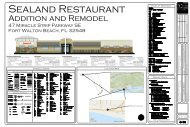


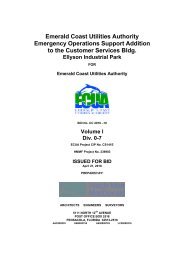
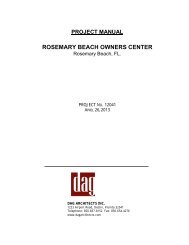
![P654 - [PROJECT.TOC] - Lord and Son Construction, Inc.](https://img.yumpu.com/36154538/1/190x245/p654-projecttoc-lord-and-son-construction-inc.jpg?quality=85)
